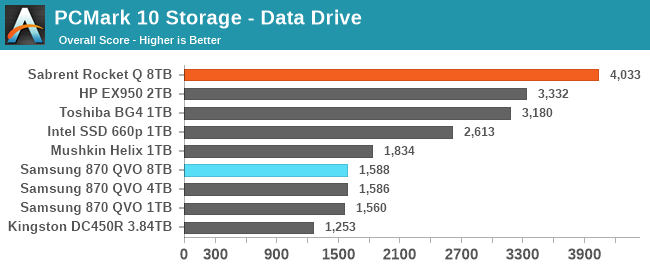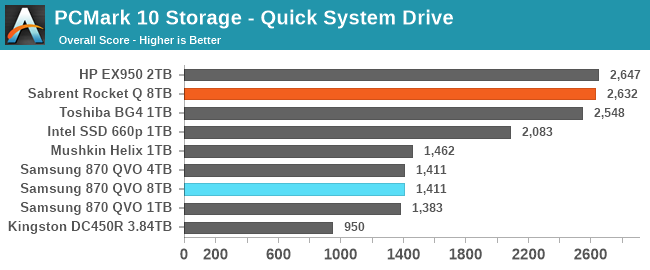QLC Goes To 8TB: Samsung 870 QVO and Sabrent Rocket Q 8TB SSDs Reviewed
by Billy Tallis on December 4, 2020 8:00 AM ESTPCMark 10 Storage Benchmarks
At the end of 2019, UL released a major update to their popular PCMark 10 benchmark suite, adding storage performance tests that had been conspicuously absent for over two years. These new storage benchmarks are similar to our AnandTech Storage Bench (ATSB) tests in that they are composed of traces of real-world IO patterns that are replayed onto the drive under test. We're incorporating these into our new SSD test suite, and including our first batch of results here.
PCMark 10 provides four different storage benchmarks. The Full System Drive, Quick System Drive and Data Drive benchmarks cover similar territory to our ATSB Heavy and Light tests, and all three together take about as long to run as the ATSB Heavy and Light tests combined. The Drive Performance Consistency Test is clearly meant to one-up The Destroyer and also measure the worst-case performance of a drive that is completely full. Due to time constraints, we are not yet attempting to add the Drive Performance Consistency Test to our usual test suite.
| PCMark 10 Storage Tests | ||
| Test Name | Data Written | |
| Data Drive | 15 GB | |
| Quick System Drive | 23 GB | |
| Full System Drive | 204 GB | |
| Drive Performance Consistency | 23 TB + 3x drive capacity | |
The primary subscores for the PCMark 10 Storage benchmarks are average bandwidth and average latency for read and write IOs. These are combined into an overall score by computing the geometric mean of the bandwidth score and the reciprocal of the latency score. PCMark 10 also records more detailed statistics, but we'll dig into those in a later review. These PCMark 10 Storage test runs were conducted on our Coffee Lake testbed:
| AnandTech Coffee Lake SSD Testbed | |
| CPU | Intel Core i7-8700K |
| Motherboard | Gigabyte Aorus H370 Gaming 3 WiFi |
| Chipset | Intel H370 |
| Memory | 2x 8GB Kingston DDR4-2666 |
| Case | In Win C583 |
| Power Supply | Cooler Master G550M |
| OS | Windows 10 64-bit, version 2004 |
Data Drive Benchmark
The Data Drive Benchmark is intended to represent usage a secondary or portable drive may be subject to. This test simulates copying around files, but does not simulate the IO associated with launching and running applications from a drive.
 |
|||||||||
| Overall Score | Average Bandwidth | Average Latency | |||||||
Starting off, the 8TB Sabrent Rocket Q leads the field thanks to its massive and fast SLC cache; it clearly outperforms even the decently high-end 2TB TLC-based HP EX920. The several capacities of the Samsung 870 QVO all performa about the same: less than half the speed of the faster NVMe drives, and slower than the slowest entry-level NVMe drives. The enterprise SATA drive with no SLC caching comes in last place.
Quick System Drive Benchmark
The Quick System Drive Benchmark is a subset of the Full System Drive Benchmark, running only 6 out of the 23 sub-tests from the Full test.
 |
|||||||||
| Overall Score | Average Bandwidth | Average Latency | |||||||
Moving on to the Quick test, the Sabrent Rocket Q no longer stands out ahead of the other NVMe drives, but still offers decent performance. The performance gap between the NVMe drives and the Samsung 870 QVO drives has narrowed slightly, but is still almost a factor of two.
Full System Drive Benchmark
The Full System Drive Benchmark covers a broad range of everyday tasks: booting Windows and starting applications and games, using Office and Adobe applications, and file management. The "Full" in the name does not mean that each drive is filled or that the entire capacity of the drive is tested. Rather, it only indicates that all of the PCMark 10 Storage sub-tests are included in this test.
 |
|||||||||
| Overall Score | Average Bandwidth | Average Latency | |||||||
The Full test starts to bring the downsides of QLC NAND into focus. The Sabrent Rocket Q is now the slowest of the NVMe drives, only moderately faster than the 8TB Samsung 870 QVO. The 1TB 870 QVO is also falling behind the larger and faster models. However, the QLC-based Intel 660p manages to hold on to decent performance, possibly a result of the class-leading SLC cache performance we usually see from Silicon Motion NVMe controllers paired with Intel/Micron flash.










150 Comments
View All Comments
shelbystripes - Thursday, December 10, 2020 - link
Dude, you don't seem to understand how "consumerist capitalism" DOES work. QLC will still be more than good enough for most consumers, or at least, that's what manufacturers are banking on. They still need to sell the hardware, and they're competing in a world where MLC and TLC SSDs still widely exist.The only way to get there will be lower cost... and there will be plenty of consumers who respond to high-capacity QLC SSDs at lower costs than "scale" alone can achieve for MLC or TLC drives, and who won't care about the drop in MTBF because QLC SSDs still have more total writes than they'll ever need. QLC SSDs aren't going to be for everyone, but if TLC (even 3D TLC) is such cheap technology that "scale" is all you need to hit 8TB SSDs with it, why isn't anyone making sub-$1K 8TB 3D TLC drives and competing with these? Shouldn't they be?
You just don't know what you're talking about, yet you have the arrogance of someone prepared to speak for everybody uniformly.
boozed - Saturday, December 5, 2020 - link
The Sabrent appears to perform quite well in real world tests, regardless of its synthetic/theoretical performance. Is this a bad thing?Hixbot - Saturday, December 5, 2020 - link
MLC/TLC is still available at extra cost. Meanwhile QLC is pushing HDDs out of the market.Oxford Guy - Sunday, December 6, 2020 - link
"MLC/TLC is still available at extra cost."Economy of scale. QLC is an attack on TLC and MLC.
Oxford Guy - Sunday, December 6, 2020 - link
Also the article says:"QLC NAND offers just a 33% increase in theoretical storage density, but in practice most QLC NAND is manufactured as 1024Gbit dies while TLC NAND is manufactured as 256Gbit and 512Gbit dies."
Which means manufacturers are trying to kneecap TLC to push QLC.
Spunjji - Monday, December 7, 2020 - link
Or it means that manufacturing TLC at those capacities per die would result in a bloated die size with decreased yields, increased costs, and too-few dies per drive to reach competitive speeds at the most common capacities.The problem with having a conclusion and looking for evidence to support it is that you can come up with all sorts of silly reasons for things that are perfectly explicable by other means.
Oxford Guy - Thursday, December 10, 2020 - link
Speculativeshelbystripes - Thursday, December 10, 2020 - link
It's ironic that you respond to someone calling out your unsubstantiated speculation as "speculative". If you're opposed to speculation, you should retract your statements assuming that manufacturers are out to "kneecap" MLC/TLC like they have some secret agenda against higher-reliability parts...Spunjji - Monday, December 7, 2020 - link
Do you have any evidence that would support that claim? Say, TLC costs rising even as QLC rolls out, in a way that doesn't reflect the usual industry supply/demand fluctations?Oxford Guy - Thursday, December 10, 2020 - link
Yes. The die sizes offered with TLC are 50% smaller at best. That magnifies the 30% density increase of QLC automatically. Maybe this reply will stick. Here’s to hoping.